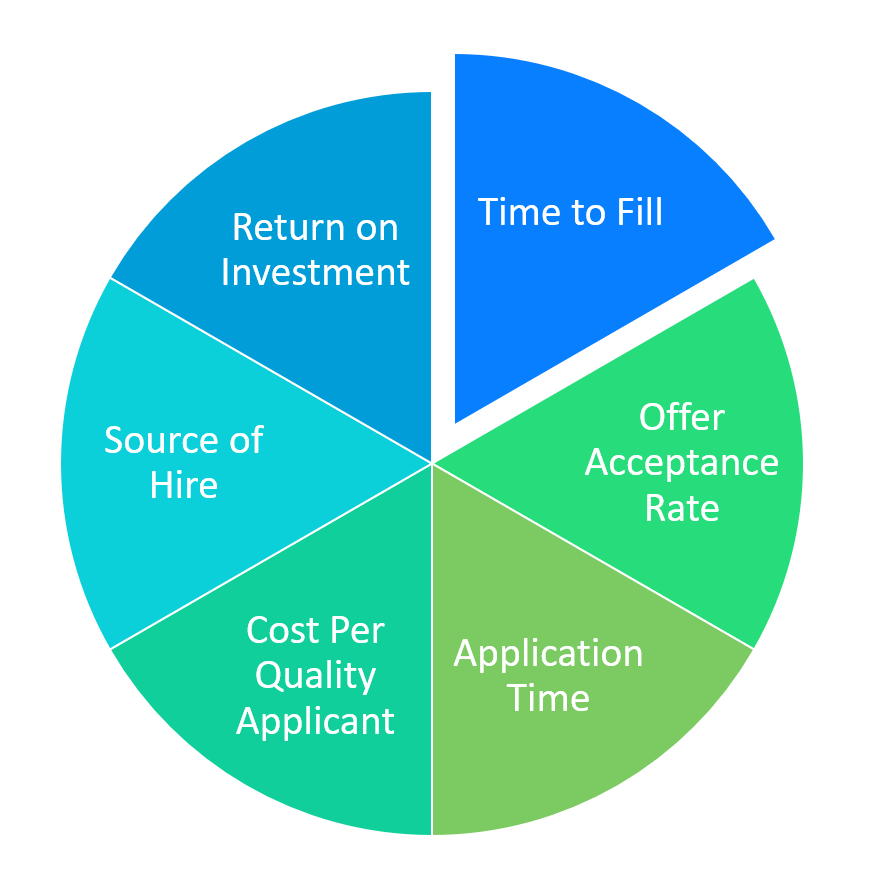Modern recruiting is rooted in metrics. How fast you can fill your open positions, how much you pay for your recruitment advertising efforts, how many candidates actually accept the offers you extend…it’s all important for measuring success.
But high volume recruiters face unique challenges, and have to approach their recruiting strategies differently than recruiters who focus on filling one-off positions; it’s like a whole different ball game.
So, when it comes to high volume recruiting, what metrics matter most?
Keep reading to learn the high volume recruiting metrics that matter so you can start setting your own benchmarks and tracking the success of your recruitment efforts.
High Volume Recruiting Metrics that Matter
Time to Fill (TTF): The amount of time it takes for a requisition to be filled, starting from the first day the role is open, and ending with the day an offer is accepted.
When you’re looking to fill a lot of open roles, or evergreen jobs, the amount of time it takes to fill those roles is pivotal. For each and every day that a role is left open, your organization loses money. According to SHRM’s 2016 Human Capital Benchmarking Report, the average Time to Fill is 42 days.
Think about everything that goes into your recruiting: the amount of individual recruiters and their salaries, the spend poured into your recruitment advertising efforts, and the costs of the actual screening, interviewing, and hiring processes. How much spend do you think makes up that 42 days?
Understand your TTF, and look for ways to optimize your practices for efficiency, to drive the candidate volume you need, and fill your open positions faster.
Offer Acceptance Rate: The ratio of job offers accepted by candidates compared to the amount of job offers extended by companies.
Filling your candidate pipeline with applications shouldn’t be the only thing you focus on. The amount of candidates who accept your employment offers is an equally important metric. After all, does the amount of candidates in your pipeline matter if candidates aren’t actually accepting offers to fill your open jobs?
Application Time: How long it takes a candidate to apply for a job.
You may be thinking, ‘What does my application time have to do with my high volume recruiting metrics?’
As it turns out, a lot. The more friction in your apply process, like making candidates create an account and manually fill in resume information, the less likely candidates are to actually complete your application. An apply time of 5 minutes or less is ideal, and can help increase applicant flow by over 300%
A high volume recruiting best practice is to keep your applications short and sweet. Pay attention to where in the process candidates drop off, and make sure your application is optimized for mobile applies. Don’t make someone work just to get to the “Submit Application” button.

Cost-Per-Quality-Applicant (CPQA): The definition of “quality” is up to the discretion of each hiring organization, whether that definition of quality is a candidate who receives a phone screen or hiring manager review.
Recruitment advertising plays an integral role in a high volume recruiting strategy. As such, the amount of money spent on that advertising directly impacts your bottom line and goals.
In traditional job advertising, cost-per-click ads would charge employers for every click on their sponsored job posting, regardless of whether or not the job seeker ended up applying. With a cost-per-applicant model, however, you only incur a cost when you receive an applicant (in other words, an potentially hireable candidate).
We recommend taking this model a step further, to focus on the cost-per-quality-applicant generated by your recruitment advertising. Doing so will enable you to accurately measure how much money is being spent to bring in qualified, hireable candidates, and will aid you in setting benchmarks against which to measure your various applicant sources.
Source of Hire (SoH): The original source, like a job board or your corporate Careers Site, that a candidate first found and clicked through to your open job.
Speaking of evaluating your applicant sources, Source of Hire (SoH) is a valuable metric to measure as part of your high volume recruiting efforts.
Not all sources perform the same, and sources that perform well for certain types of roles might perform poorly for others. It’s important that when you evaluate your sources, you focus on metrics as close to a hire as possible, like cost-per-quality-applicant. Using the same metric will help you better benchmark how each source performs, and evaluate which make sense to continue investing in.
Return on Investment (ROI): Taken literally, how much return (in the form of whichever performance media is chosen) is made when money is invested in your high volume recruitment strategy.
Measuring ROI is key for any part of a business, and recruiting is no exception.
ROI, or Return on Investment, is a way for teams to show that the time, effort, and resources they put into a certain project has benefited their organization positively.
In the world of recruiting, a way to measure ROI is to segment your recruitment advertising spend into campaigns, and track how many candidates and hires those campaigns generate. As you fill more open positions, you provide your organization valuable employees who will contribute to the overall success of your company and its bottom line.
Understanding High Volume Recruiting Metrics
Every day, the world is becoming more data-focused. Marketers use data to analyze their content campaigns, sales people use data to segment their leads, and recruiters use data to find qualified candidates.
Now, I know what you may be thinking – you went into recruiting because you’re a people person, not a numbers person – and I get it. If I had known how much math was involved in marketing before pursuing it, I might have thought twice!
But the truth is, understanding the metrics that impact your day-to-day tasks, as well as your team and company goals, is pivotal for being successful in your role. Setting benchmarks for your Time to Fill, acceptance rate, application time, advertising costs, and hiring sources (and using all of those benchmarks to track the ROI of your efforts) will give you the ability to make better, more informed choices with your strategy and enable you to drive the most impact.
So, get your calculator out, and start crunching those numbers! You’ll be happy you did.
For more best practices in high volume recruitment, check out this blog post.


